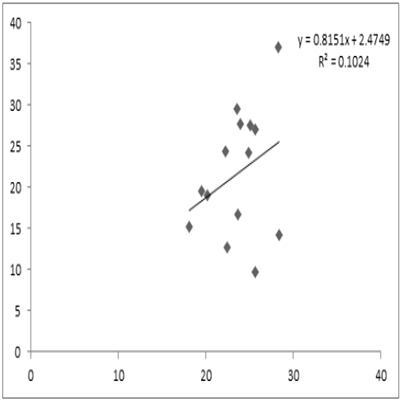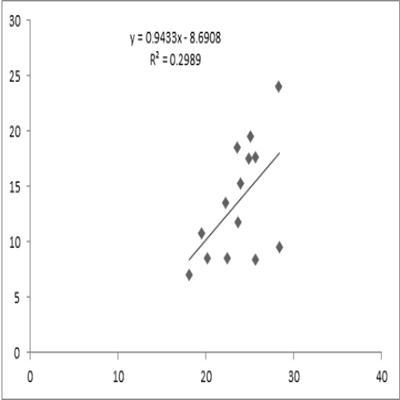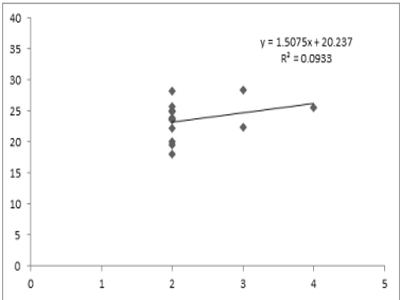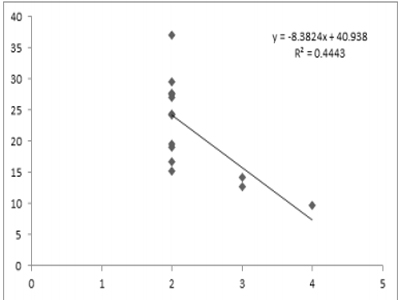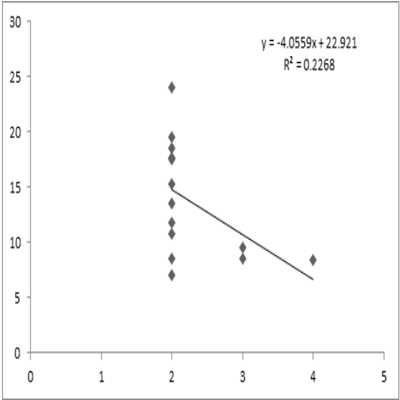Previous Issues Volume 1, Issue 1 - 2018
Preliminary Research: Relationships between Body Mass Index, Body Fat and Physical Activity in University Students
Adela Gómez Luque1 *, María Alcalá Cerrillo2 , Laura Bermejo Sánchez3 , María Zoraida Clavijo Chamorro1
1Department of Nursing, School of Nursing and Occupational Therapy, Cáceres, University of Extremadura, Spain 2Department of surgical doctor. School of Nursing and Occupational Therapy, Cáceres, University of Extremadura, Spain. 3Main Theatres Departament, John Radcliffe Hospital, OX3 9DU, Oxford (England).
Corresponding Author: Adela Gómez Luque, Avda de la Universidad s/n. C.P.: 10.003. Cáceres. Spain, Tel: 687147294; E-Mail: [email protected]
Received Date: 21 Feb 2018 Accepted Date: 18 May 2018 Published Date: 2 May 2018
Copyright © 2018 Luque AG
Citation: Luque AG, Cerrillo MA, Sánchez LB and Chamorro MC. (2018). Preliminary Research: Relationships between Body Mass Index, Body Fat and Physical Activity in University Students. Mathews J Nurs. 1(1): 004.
ABSTRACT
Objectives: The objective was to conduct a study of impedance to analyze the obtained values and establish relationships between body composition and physical activity in a population of students of varying ages in Extremadura.
Materials and Methods: Preliminary research, descriptive, correlational, transversal conducted with a sample of 14 subjects, with average age of 27.5 years, 5 male and 9 female, it assessed the relationship between physical activity (PA), Body mass index (BMI), and percentage of body fat (FM %) and mass fat kg (FM kg), by means of electrical bioimpedance and IPAQ international questionnaire.
Results: It was noted correlation between PA - FM % in men (r = 0. 951) BMI - FM % in women (r = 0. 895) and between BMI - FM kg in women (r = 0. 948). The p-value was significant for FM % between men and women.
Conclusions: There is relationship between physical activity (PA), body mass index (BMI) and fat mass (FM). Likewise, we should implement programs to increase physical activity among adults. Further researches would be necessary to obtain really robust conclusions.
Keywords: Body Composition; Nutritional State; Physical Fitness; Motor activity; Bioelectrical Impedance.
INTRODUCTION
There are many studies carried out on body composition in order to characterize the populations.
The index of Corporal mass (BMI) has become one of the main variables of measure used in different studies. The proportion of weight measured in kilograms divided by the square of the height measured in metres called Quetelet index and was subsequently renamed as BMI (BMI) [1].
There are studies that correlate the BMI with the composition of the individual FM [2-3] establishing a directly proportional relationship between both of these parameters. However Fernandez_Real and Cols [4] determines that it is impossible to compare the prevalence of obesity among different populations using the BMI exclusively, having drawn from their results that the relationship between BMI and FM % is less Spain than that of Caucasian populations, then the relationship between BMI and FM % is not uniform among populations.
Weight, height, the fat by weight (FM) and the percentage of fat mass (FM %) are some of the values that can be obtained from a study of impedance and through the evaluation of the results obtained can establish multiple correlations to evaluate the State of health and nutrition of individuals and populations.
The impedance is a method of non-invasive, cheap and easy to handle that it can be used to make an analysis of body composition and there has been using in recent decades as a fundamental tool in studies of public health, based his study on two parameters: the body electrical resistance and reactance [5].
Many studies have examined the relationship between body composition and bone mineral density, but little attention has been paid to how these relationships vary with age and sex [6]. Most of the studies which provide this kind of relationship focus at an early age as the children and adolescents, with emphasis on primary prevention of obesity.
It has been shown that the benefits of physical activity produce maintenance or prevention of an increase in the BMI which in turn is correlated with an increase of mass prevention grease for physically active subjects [7].
Normal weight adults participate in activities of moderate and strong intensity and longer duration than people with overweight or obesity [8].
A review of 17 articles, found that 60% of studies established an inversely proportional relationship between the both percent fat with physical activity. Physical activity is inversely proportional to the percentage of body fat in preschool children. Additional studies that directly use the measures of physical activity and the percentage of fat to define the adiposity to draw stronger conclusions are needed [9].
The objective is to conduct a study of impedance to analyse the obtained values and establish relationships between body composition and physical activity in a population of students of varying ages in Extremadura.
The lack of uniformity in the relationship between BMI - FM % between populations and the many factors that influence obesity requires the realization of this type of study in different geographical points in order to be able to establish health programmes aimed at prevention and standard values as possible related to the reality in the future.
MATERIAL AND METHODS
Preliminary research that aims to test and determine the validity of the instruments and techniques used to perform further large scale investigations. It is a descriptive, correlational, transversal study carried in the Nursery and Occupational Therapy School from the University of Extremadura (Spain) through the selection of a group of 14 students enrolled in the University Master on Health Science Investigation, given at such school with a median age of 27.5, 5 male and 9 female.
Previously was a sample of 15 subjects, but he had to exclude one of them by not having turned up properly to the data collection session. All the subjects expressed their consent.
The studied variables were anthropometric measures (weight and height), the percentage of body fat and the degree of activity of each of the subjects.
To evaluate anthropometric measures we use a digital scale and an estadiómetro, scoring data in kilograms and centimeters respectively. Measured them and weighed only once, removing only shoes.
Body fat percentage was determined by means of bioimpedance electrical using the OMROM BF300 instrument. This device is used to carry out a technique based on the resistance offered by the water and the body tissues to the passage of an electric current, the resistance is determined by the contents of water and electrolyte content. And as a result offers the fat mass in Kg and %.
We must consider the used bioimpedanciometro wasn't programmed to adjust the weight, making the corresponding subtraction of the weight of the clothes.
Each subject is explained previously on that was the test and should make. They should remove all metal objects which carry in their hands, placed in standing with the bioimpedanciómetro between the hands and arms stretched forward. This technique should be three consecutive times to obtain more precise results. However, it was only performed once, because the instrument was calibrated by an external company, showing results of very high precision with a single measurement.
As regards the assessment of physical activity of subjects used international questionnaire IPAQ, which provides 4 forms of physical activity: sedentary, moderately active and competitive. These qualitative data were converted to quantitative, values ranging from 1 through 4 respectively, to facilitate its handling in Excel tables.
All variables (weight, size, age, gender, mass, fat Kg and % and physical activity) were recorded in a table. The determination of each one of them was made in a single afternoon consecutively, without taking into account the nutritional status in the who were the subjects (fasting or recent intake) and without the knowledge of the pattern of recent elimination. The Excel was used for comparisons, taking P < 0,05 as the minimum level significance.
RESULTS
Table 1, shows the SEM± SD expressed results of the following parameters: age, BMI, % FM, FM kg and PA differentiated by gender. Likewise, show the correlation between the BMI and % FM and FM kg and the correlation between BMI and FM and FM kg % PA.
Table 1: Averages of the characteristics of the group and relationship with physical activity for each genus and the total sample.
| AGE SEM ±SD | BMI SEM ± SD | %FM SEM ± SD | FM kg SEM ± SD | PA SEM ± SD | BMI-%FM R2 | BMIFM Kg R2 | BMI-PA R2 | PA-%FM R2 | PA-FM Kg R2 | |
| TOTAL n = 14 | 27.5 ± 9.38 | 23.68 ± 3.02 | 21.78 ± 7.69 | 13.65 ± 5.21 | 2.29 ± 0.61 | 0.1024 | 0.2989 R = 547 | 0.0933 | 0.4443 | 0.2268 |
| R = 0. 32 | ||||||||||
| Below Elbow | APB | 14.1(=6.0) | 7.2 | 56.1(=50) | ||||||
| MALE n = 5 | 22.2 ± 1.30 | 23.70 ± 2.74 | 13.74 ± 2.79 | 9.08 ± 1.75 | 2.8 ± 0.84 | 0.0951 | 0.2123 | 0.3424 | 0.9051 | 0.0591 R =0.243 |
| R = 0.308 | R=0.46 | R =0.951 | ||||||||
| FEMALE n = 9 | 30.44 ± 10.71 | 23.65 ± 3.81 | 26.24 ± 5.44 | 16.19 ± 4.71 | 2± 0 | 0.8015 | 0.8995 | N/D | N/D | N/D |
| R = 0.895 |
SEM: Standard Error of the Mean SD = Standard deviation n = Sample size BMI = Body mass index FM Kg = mass fat kg PA = Physical activity FM %= percentage of body fat
N/D: No one can calculate regression of PA-BMI, PA - FM or PA-KgFM % because physical activity in women is the same (moderate).
- P-value BMI by sex: (not significant) 0.9758
- P-value % FM by sex: 0.00046 (significant)
- P-value Kg FM by sex: 0.0076 (not significant)
The p-value is significant only for FM % between men and women however does not show significance between BMI and FM kg between men and women.
Figure 1 shows correlationship between BMI and %FM (n = 14), there is correlation between BMI and FM % in women (r = 0, 895), however is not correlation between male (r = 0.308).
Figure 1: Correlationship between BMI and FM in proportion (n = 14), r = 0.32.
Figure 2 shows correlationship between BMI and FM in Kg (n = 14), there is correlation between BMI and FM kg in women (r = 0, 948), however, is not correlation between men (r = 0.46).
Figure 2: Correlationship between BMI and FM in Kg (n = 14), r = 0. 547.
We have made a correlation between PA and different anthropometric data being the most relevant ones which are described below:
Figure 3 does not show significance between BMI and PA neither men nor women.
Figure 3:Correlationship between PA and BMI (n = 14), r = 0.305.
Figure 4 shows correlationship between PA and %FM (n = 14). There is correlation between PA and %FM in men (r = 0,951), however it was not calculated regression of PA-%FM because physical activity in women is the same (moderate).
Figure 4: Correlationship between PA and FM in proportion (n = 14) r = 0. 66
Finally the Figure 5 concerning the relationship between the PA and FM kg, determines that there is no correlation between two parameters in either of the two sexes.
Figure 5: Correlationshipe PA and FM kg (n = 14) r = 0. 47
DISCUSSION
We have obtained significant correlations between BMI and FM kg as FM % with r = 0. 948 BMI/FM kg and r = 0. 895 BMI/ FM % for women with SEM ±SD = 30.44 ± 10.71. Martín-More no et [10] conducted a randomized study in 2002 on women aged between 35 and 55 years and also observe a strong correlation between the BMI and FM (r = 0. 919) which confirms our results. In the case of males (n = 5) are less correlation between BMI/FM, possibly attributed to the sample size.
Another problem found was, little variability that showed the female subjects with respect to physical activity (100% of the cases n = 14, they expressed having moderate physical activity), which has not allowed us to obtain any valid correlation between the PA with the anthropometric parameters (BMI, % FM and FM kg) makes us ask ourselves if the homogeneity of the answers correspond to a selection bias or again has been the result of the low sample studied.
Other studies such as the one done by Kyle et to [7] in 2001, saying that the PA could limit the FM in women until the age of 45, which could have led us to think about the possibility of obtaining similar results to be counted with a sample that matches the results exposed by Kyle age et to the. Zamboni et al [11] also concludes in his study, physical sidability is related to the FM and BMI in older women.
In the case of males subject, we have only been able to establish correlation between the PA and FM % by having a sample more variable in which the PA is concerned (SEM ±SD = 2. 8±0. 84) but with fewer subjects under study. Within the constraints posed by the sample size, we have seen a correlation of r = 0. 951 between PA and FM %, propping up this result obtained by Kyle et to 7 that as women, States that the PA is a limiting factor of the FM in males over the age of 25.
In our study, we have seen a lower percentage of FM in males that in women with a significance of p < 0.0005, however there is no significance regarding the BMI among both genders. Tudor-Locke et al. to [12] carried out a study in which they relate the PA with the BMI and agree that women have one FM lower than that of men, both in Caucasian as AfricanAmerican, but observed no significance in the BMI between men and women of Caucasian or African-American.
In view of these data, one might ask the need to establish relations of BMI and FM according to the study populations and concluded Fern-ndez-Real et al. to [4] in 2001 in his study of the BMI and % FM in order to come closer to social reality.
In the light of the results obtained and the bibliography consulted arises us the need to elevate this study to one larger population to obtain applicable data to it.
Likewise, we should implement programs to increase physical activity among adults. Further researches with a bigger number of subjects would be necessary as well as a more specific assessment of physical activity level to obtain really robust conclusions.
REFERENCES
- Keys A, F Fidanza, Karvonen MJ, Kimura N, et al. (1972). Indices of relative weight and obesity. Dis j. chronic. 25(6): 329-343.
- Sotillo C, Lopez-Jurado M, Aranda P, Lopez-Frias M, et al. (2007). Llopis j. Body composition in an adult population in southern Spain: influence of lifestyle factors. Int J Vitam Nutr Res. 77(6): 406-414.
- Sallinen J, Stenholm S, Rantanen T, Helioaara M, et al. (2011). Effect of age on the association between body fat percentage and maximal walking speed. J Nutr Health Aging. 15(6): 427-432.
- Fernandez-Real JM, Vayreda M, R Casamitjana, Saez M, et al. (2001). [Body mass index (BMI) and fat mass percent.] [To BMI > 27.5 kg/m2 could be indicative of obesity in the Spanish population]. Med Clin (Barc) 17(18): 681-694.
- Barbosa-Silva MC, Barros AJ, Wang J, Heymsfield SB, et al. (2005). Bioelectrical impedance analysis: population reference values for phase angle by age and sex. Am J Clin Nutr. 2(1): 49-52.
- Cheng Q, Zhu YX, Zhang MX, LH Li,et al. (2012). Age and sex effects on the association between body composition and bone mineral density in healthy Chinese men and women. Menopause. 19(4): 448-455.
- Kyle UG, Gremion G, Genton L, Slosman OJ, et al. (2001). Physical activity and fat-free and fat mass by bioelectrical impedance in 3853 adults. Med Sci Sports 33(4): 576-584.
- Spees CK, Scott JM and Taylor CA. (2012). Differences in Amounts and Types of Physical Activity by Obesity Status in US Adults. Am J Health Behav. 36(1): 56-65.
- Sijtsma A, Sauer PJ, Stolk RP and Corpeleijn E. (2011). Is directly measured physical activity related to adiposity in preschool children? Int J Pediatr Obes. 6(5-6): 389-400.
- Martin MV, Gomez Gandoy JB, Gomez dlC and Antoranz Gonzalez MJ. (2002). [Body fat and fat mass-fat free mass ratio estimated by bioelectric impedance in the nutritional evaluation of women 35-55 years of age]. Rev Esp Health publishes. 76(6): 723-734.
- Zamboni M, Turcato E, Santana H, Maggi S, et al. (1999). The relationship between body composition and physical performance in older women. J Am Geriatr Soc. 47(12): 1403-1408.
- Tudor-Locke C, Ainsworth BE, Whitt MC, Thompson RW, et al. (2001). The relationship between pedometer-determined ambulatory activity and body composition variables. Int J Obes Relat Metab Disord. 25(11): 1571-1578.
